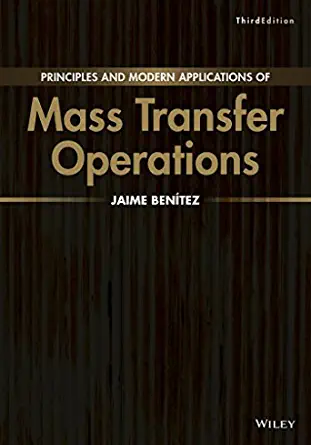Answered step by step
Verified Expert Solution
Question
1 Approved Answer
Dynamic Model of the Reactor Consider the following Ordinary Differential Equations model of the ammonia reactor: d T f d x = - u S
Dynamic Model of the Reactor Consider the following Ordinary Differential Equations model of the ammonia reactor: where exp exp Page of C Department of Chemical Engineering, University College London, is the molar flowrate of per area catalyst in moles is temperature of feed gas in is temperature of reacting gas in is reactor length in The constant parameters in the model are heat capacity of the feed gas, heat capacity of reacting gas, catalyst activity, heat of reaction, kcapartial pressure of a component, psiideal gas constant, surface area of catalyst tubes per unit length of reactor, cross sectional area of catalyst zone, overall heat transfer coefficient, total mass flowrate, Q: Steadystate operation: Assume that the reactor is operating at steadystate, ie ODE equations and can be replaced by the following algebraic equations: Solve these nonlinear algebraic equations for using the CNS solver in GAMS. Submit the GAMS gms file and report the solution obtained. Do not submit the lst file. 
Dynamic Model of the Reactor
Consider the following Ordinary Differential Equations model of the ammonia reactor:
where
exp
exp
Page of
C Department of Chemical Engineering, University College London,
is the molar flowrate of per area catalyst in moles is temperature of feed gas in is
temperature of reacting gas in is reactor length in The constant parameters in the model are heat
capacity of the feed gas, heat capacity of reacting gas, catalyst
activity, heat of reaction, kcapartial pressure of a component, psiideal gas
constant, surface area of catalyst tubes per unit length of reactor, cross
sectional area of catalyst zone, overall heat transfer coefficient, total
mass flowrate,
Q: Steadystate operation: Assume that the reactor is operating at steadystate, ie ODE equations
and can be replaced by the following algebraic equations:
Solve these nonlinear algebraic equations for using the CNS solver in GAMS.
Submit the GAMS gms file and report the solution obtained. Do not submit the lst file.
Step by Step Solution
There are 3 Steps involved in it
Step: 1

Get Instant Access to Expert-Tailored Solutions
See step-by-step solutions with expert insights and AI powered tools for academic success
Step: 2

Step: 3

Ace Your Homework with AI
Get the answers you need in no time with our AI-driven, step-by-step assistance
Get Started


